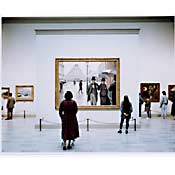
In his celebrated “Museum Photographs,” Thomas Struth portrays the modern crowd browsing through our culture. We see this crowd pushing into the Stanze di Raffaello in Rome; sitting on the steps of the Milan Cathedral; admiring Géricault’s Raft of the Medusa in the Louvre. As we stand there, the photographs begin to make us self-conscious: We look at ourselves looking at people who look like us looking at art. Artful self-consciousness of this kind can arouse exasperated impatience. It can easily become a form of intellectual preening—more ripples in the pool of Narcissus, in which our culture is drowning. But something more mysterious and fruitful pervades the work of this German photographer, who is now the subject of a retrospective at the Metropolitan Museum of Art.
Organized by the Dallas Museum of Art (Maria Morris Hambourg and Douglas Eklund are the show’s curators at the Met), Thomas Struth contains about 90 images that reflect various aspects of the artist’s oeuvre. From the beginning of his career, Struth has been preoccupied by the street. In contrast to the sweatier tradition of street photography—carried on by photographers who welcome the tremble of the hand and the blink of the eye—Struth early on assumed a more dispassionate perspective. It can almost seem as if he didn’t create the images, yet his approach is not as cool, abstract, or “handless” as that of many of his contemporaries. In his art, a kind of overarching presence—something elevated and unmechanical—appears to divine the many broken rhymes of the contemporary street. I don’t know what to call that something, but it seems more post-spiritual than postmodern.
Struth’s pictures of lush jungle, made after the Berlin Wall was torn down, are entitled “Paradise.” Almost no contemporary artist will use the word paradise without irony, Struth included. But his Edenic images aren’t just ironic. They are also iconic. Unlike most postmodernists, he doesn’t enervate the past or its ideas with condescension. He gives paradise its due: We cannot easily dismiss it. The pictures answer our objections, as if to say, “Of course not, but why not?” Struth has also made a number of marvel-filled images imbued with this sort of nuanced feeling, skirting the edge between desire and hokum. In one picture of Las Vegas, we see a little stage-set village over which a modern hotel looms. The hokey village is delightful—not just something to scoff at, analyze socially, or treat as charming kitsch. His pictures of people also subtly upset our expectations. In the Western tradition, portraiture usually offers an occasion to examine the subject from a position of safety. In Struth’s portraits and family studies, his subjects accept the inquiring gaze of the viewer. At the same time, their stares bounce the question back to the viewer, asking, “Who are you?”
That is one secret of the museum pictures: They let the art talk back. If the browsers at the museum appear transient, casual, and random, the art they come to see is still, exacting, and formal. (Struth’s color is lushly romantic, a chromatic orchestration for the many-sided reverie released by the images.) Occasionally, as in
•Openings & Closings
•Museums
•Galleries
•Photography
•More
Thomas Struth
Photographs, at the Metropolitan Museum of Art; through 5/18.
See Art listings for details.